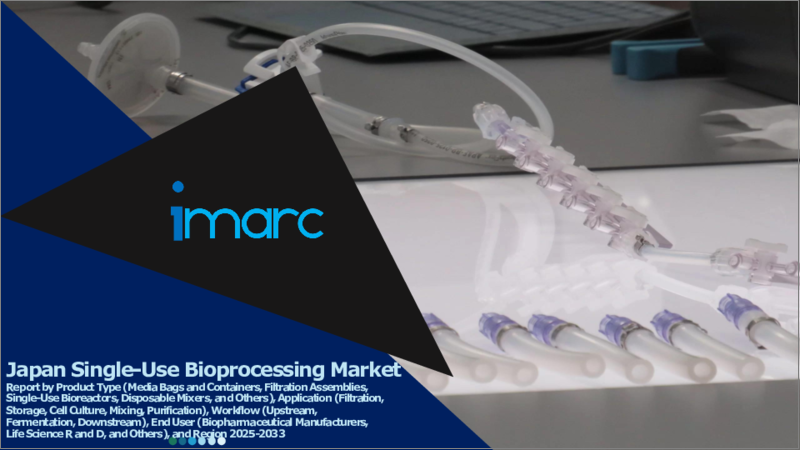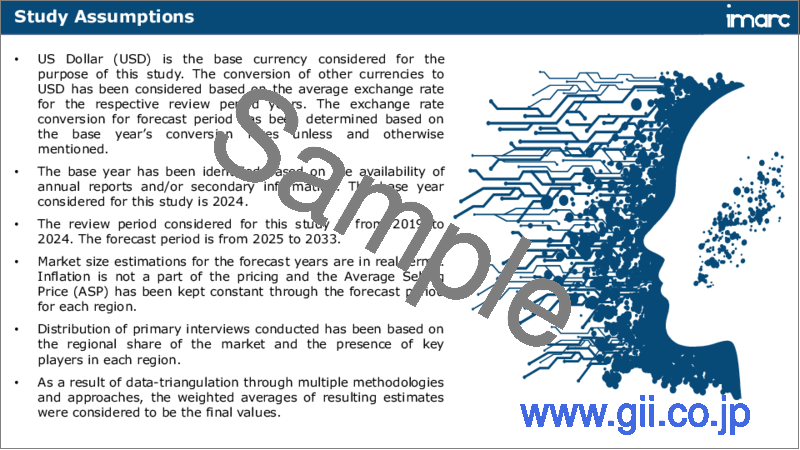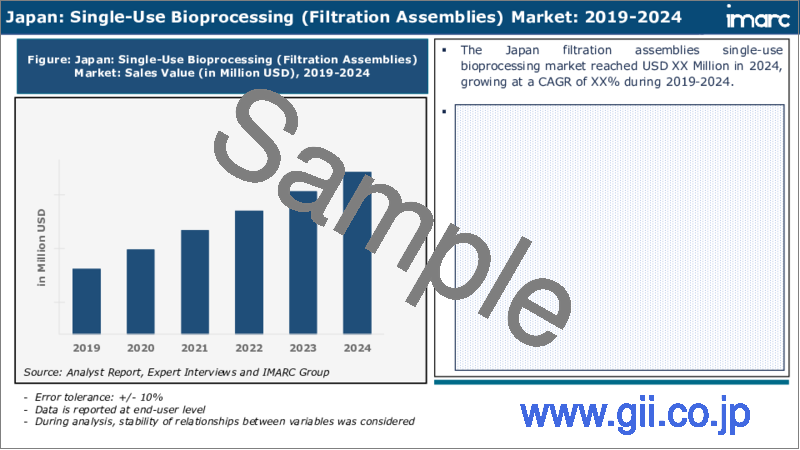|
|
市場調査レポート
商品コード
1609729
日本のシングルユースバイオプロセシング市場レポート:製品タイプ、用途、ワークフロー、最終用途、地域別、2025年~2033年Japan Single-Use Bioprocessing Market Report by Product Type, Application, Workflow, End User, and Region 2025-2033 |
||||||
カスタマイズ可能
|
|||||||
| 日本のシングルユースバイオプロセシング市場レポート:製品タイプ、用途、ワークフロー、最終用途、地域別、2025年~2033年 |
|
出版日: 2024年12月05日
発行: IMARC
ページ情報: 英文 119 Pages
納期: 5~7営業日
|
全表示
- 概要
- 目次
日本のシングルユースバイオプロセシング市場の市場規模は2024年に12億4,140万米ドルに達しました。今後、IMARC Groupは、市場は2033年までに58億1,580万米ドルに達し、2025年から2033年にかけて16.7%の成長率(CAGR)を示すと予測しています。シングルユースバイオプロセシングシステムの性能と信頼性を向上させた、生体適合性プラスチックやポリマーなどの革新的材料の開発が、市場を牽引しています。
本レポートで扱う主な質問
- 日本のシングルユースバイオプロセシング市場はこれまでどのように推移し、今後どのように推移していくのか?
- COVID-19の日本のシングルユースバイオプロセシング市場への影響は?
- 日本のシングルユースバイオプロセシング市場の製品タイプ別の内訳は?
- 日本のシングルユースバイオプロセシング市場の用途別内訳は?
- 日本のシングルユースバイオプロセシング市場のワークフロー別の内訳は?
- 日本のシングルユースバイオプロセシング市場のエンドユーザー別の内訳は?
- 日本のシングルユースバイオプロセシング市場のバリューチェーンにはどのような段階がありますか?
- 日本のシングルユースバイオプロセシングにおける主な促進要因と課題は何か?
- 日本のシングルユースバイオプロセシング市場の構造と主要プレーヤーは?
- 日本のシングルユースバイオプロセシング市場における競合の程度は?
目次
第1章 序文
第2章 調査範囲と調査手法
- 調査の目的
- ステークホルダー
- データソース
- 市場推定
- 調査手法
第3章 エグゼクティブサマリー
第4章 日本のシングルユースバイオプロセシング市場-イントロダクション
- 概要
- 市場力学
- 業界動向
- 競合情報
第5章 日本のシングルユースバイオプロセシング市場情勢
- 過去および現在の市場動向(2019年~2024年)
- 市場予測(2025年~2033年)
第6章 日本のシングルユースバイオプロセシング市場-製品タイプ別の内訳
- メディアバッグとコンテナ
- 濾過アセンブリ
- 使い捨てバイオリアクター
- 使い捨てミキサー
- その他
第7章 日本のシングルユースバイオプロセシング市場- 用途別の内訳
- 濾過
- ストレージ
- 細胞培養
- 混合
- 精製
第8章 日本のシングルユースバイオプロセシング市場- ワークフロー別の内訳
- 上流
- 発酵
- 下流
第9章 日本のシングルユースバイオプロセシング市場- エンドユーザー別の内訳
- バイオ医薬品メーカー
- ライフサイエンス研究開発
- その他
第10章 日本のシングルユースバイオプロセシング市場-競合情勢
- 概要
- 市場構造
- 市場プレーヤーのポジショニング
- 主要成功戦略
- 競合ダッシュボード
- 企業評価象限
第11章 主要企業のプロファイル
第12章 日本のシングルユースバイオプロセシング市場- 業界分析
- 促進要因・抑制要因・機会
- ポーターのファイブフォース分析
- バリューチェーン分析
第13章 付録
Japan single-use bioprocessing market size reached USD 1,241.4 Million in 2024. Looking forward, IMARC Group expects the market to reach USD 5,815.8 Million by 2033, exhibiting a growth rate (CAGR) of 16.7% during 2025-2033. The increasing development of innovative materials, such as biocompatible plastics and polymers, which has improved the performance and reliability of single-use bioprocessing systems, is driving the market.
Single-use bioprocessing is a cutting-edge approach in the field of biotechnology and pharmaceutical manufacturing that utilizes disposable components and equipment for the production of biopharmaceuticals. Unlike traditional stainless steel systems, which require extensive cleaning and validation between batches, single-use systems are designed for one-time use, reducing the risk of cross-contamination and speeding up production. Single-use bioprocessing offers several advantages, including increased flexibility, cost-efficiency, and reduced setup times. It allows for rapid scale-up or scale-down of production, making it suitable for both small-scale research and large-scale commercial production. These systems typically consist of single-use bioreactors, filtration units, and tubing assemblies, which are easy to install and replace. Furthermore, single-use bioprocessing aligns with current trends in biomanufacturing, promoting sustainability by reducing water and energy consumption and minimizing waste generation. Overall, it has revolutionized the biopharmaceutical industry by streamlining processes, improving product quality, and accelerating the development and production of life-saving drugs and therapies.
Japan Single-Use Bioprocessing Market Trends:
The single-use bioprocessing market in Japan is being propelled forward by several key drivers. First and foremost, the growing demand for biopharmaceuticals is a significant driver. As the pharmaceutical industry shifts its focus from traditional small-molecule drugs to biologics, there is an increased need for efficient and flexible bioprocessing solutions. Single-use bioprocessing technologies offer rapid deployment, reduced contamination risk, and cost-effective scalability, making them a preferred choice for many biopharmaceutical companies. Another driver is the increasing emphasis on cost savings and sustainability. Single-use systems reduce the need for complex cleaning and sterilization processes, leading to lower operational costs and a smaller environmental footprint. This aligns with the broader trend towards more sustainable and environmentally friendly practices in the healthcare and biopharmaceutical industries. Additionally, the agility provided by single-use bioprocessing systems is crucial in responding to rapidly changing market demands and shorter development timelines. They enable manufacturers to quickly adapt to different production scales and accommodate diverse product portfolios. In summary, the single-use bioprocessing market in Japan is thriving due to increased demand for biopharmaceuticals, cost savings, sustainability concerns, flexibility, and regulatory support.
Japan Single-Use Bioprocessing Market Segmentation:
Product Type Insights:
- Media Bags and Containers
- Filtration Assemblies
- Single-Use Bioreactors
- Disposable Mixers
- Others
Application Insights:
- Filtration
- Storage
- Cell Culture
- Mixing
- Purification
Workflow Insights:
- Upstream
- Fermentation
- Downstream
End User Insights:
- Biopharmaceutical Manufacturers
- Life Science R and D
- Others
Competitive Landscape:
The market research report has also provided a comprehensive analysis of the competitive landscape. Competitive analysis such as market structure, key player positioning, top winning strategies, competitive dashboard, and company evaluation quadrant has been covered in the report. Also, detailed profiles of all major companies have been provided.
Key Questions Answered in This Report:
- How has the Japan single-use bioprocessing market performed so far and how will it perform in the coming years?
- What has been the impact of COVID-19 on the Japan single-use bioprocessing market?
- What is the breakup of the Japan single-use bioprocessing market on the basis of product type?
- What is the breakup of the Japan single-use bioprocessing market on the basis of application?
- What is the breakup of the Japan single-use bioprocessing market on the basis of workflow?
- What is the breakup of the Japan single-use bioprocessing market on the basis of end user?
- What are the various stages in the value chain of the Japan single-use bioprocessing market?
- What are the key driving factors and challenges in the Japan single-use bioprocessing?
- What is the structure of the Japan single-use bioprocessing market and who are the key players?
- What is the degree of competition in the Japan single-use bioprocessing market?
Table of Contents
1 Preface
2 Scope and Methodology
- 2.1 Objectives of the Study
- 2.2 Stakeholders
- 2.3 Data Sources
- 2.3.1 Primary Sources
- 2.3.2 Secondary Sources
- 2.4 Market Estimation
- 2.4.1 Bottom-Up Approach
- 2.4.2 Top-Down Approach
- 2.5 Forecasting Methodology
3 Executive Summary
4 Japan Single-Use Bioprocessing Market - Introduction
- 4.1 Overview
- 4.2 Market Dynamics
- 4.3 Industry Trends
- 4.4 Competitive Intelligence
5 Japan Single-Use Bioprocessing Market Landscape
- 5.1 Historical and Current Market Trends (2019-2024)
- 5.2 Market Forecast (2025-2033)
6 Japan Single-Use Bioprocessing Market - Breakup by Product Type
- 6.1 Media Bags and Containers
- 6.1.1 Overview
- 6.1.2 Historical and Current Market Trends (2019-2024)
- 6.1.3 Market Forecast (2025-2033)
- 6.2 Filtration Assemblies
- 6.2.1 Overview
- 6.2.2 Historical and Current Market Trends (2019-2024)
- 6.2.3 Market Forecast (2025-2033)
- 6.3 Single-Use Bioreactors
- 6.3.1 Overview
- 6.3.2 Historical and Current Market Trends (2019-2024)
- 6.3.3 Market Forecast (2025-2033)
- 6.4 Disposable Mixers
- 6.4.1 Overview
- 6.4.2 Historical and Current Market Trends (2019-2024)
- 6.4.3 Market Forecast (2025-2033)
- 6.5 Others
- 6.5.1 Historical and Current Market Trends (2019-2024)
- 6.5.2 Market Forecast (2025-2033)
7 Japan Single-Use Bioprocessing Market - Breakup by Application
- 7.1 Filtration
- 7.1.1 Overview
- 7.1.2 Historical and Current Market Trends (2019-2024)
- 7.1.3 Market Forecast (2025-2033)
- 7.2 Storage
- 7.2.1 Overview
- 7.2.2 Historical and Current Market Trends (2019-2024)
- 7.2.3 Market Forecast (2025-2033)
- 7.3 Cell Culture
- 7.3.1 Overview
- 7.3.2 Historical and Current Market Trends (2019-2024)
- 7.3.3 Market Forecast (2025-2033)
- 7.4 Mixing
- 7.4.1 Overview
- 7.4.2 Historical and Current Market Trends (2019-2024)
- 7.4.3 Market Forecast (2025-2033)
- 7.5 Purification
- 7.5.1 Overview
- 7.5.2 Historical and Current Market Trends (2019-2024)
- 7.5.3 Market Forecast (2025-2033)
8 Japan Single-Use Bioprocessing Market - Breakup by Workflow
- 8.1 Upstream
- 8.1.1 Overview
- 8.1.2 Historical and Current Market Trends (2019-2024)
- 8.1.3 Market Forecast (2025-2033)
- 8.2 Fermentation
- 8.2.1 Overview
- 8.2.2 Historical and Current Market Trends (2019-2024)
- 8.2.3 Market Forecast (2025-2033)
- 8.3 Downstream
- 8.3.1 Overview
- 8.3.2 Historical and Current Market Trends (2019-2024)
- 8.3.3 Market Forecast (2025-2033)
9 Japan Single-Use Bioprocessing Market - Breakup by End User
- 9.1 Biopharmaceutical Manufacturers
- 9.1.1 Overview
- 9.1.2 Historical and Current Market Trends (2019-2024)
- 9.1.3 Market Forecast (2025-2033)
- 9.2 Life Science R and D
- 9.2.1 Overview
- 9.2.2 Historical and Current Market Trends (2019-2024)
- 9.2.3 Market Forecast (2025-2033)
- 9.3 Others
- 9.3.1 Historical and Current Market Trends (2019-2024)
- 9.3.2 Market Forecast (2025-2033)
10 Japan Single-Use Bioprocessing Market - Competitive Landscape
- 10.1 Overview
- 10.2 Market Structure
- 10.3 Market Player Positioning
- 10.4 Top Winning Strategies
- 10.5 Competitive Dashboard
- 10.6 Company Evaluation Quadrant
11 Profiles of Key Players
- 11.1 Company A
- 11.1.1 Business Overview
- 11.1.2 Product Portfolio
- 11.1.3 Business Strategies
- 11.1.4 SWOT Analysis
- 11.1.5 Major News and Events
- 11.2 Company B
- 11.2.1 Business Overview
- 11.2.2 Product Portfolio
- 11.2.3 Business Strategies
- 11.2.4 SWOT Analysis
- 11.2.5 Major News and Events
- 11.3 Company C
- 11.3.1 Business Overview
- 11.3.2 Product Portfolio
- 11.3.3 Business Strategies
- 11.3.4 SWOT Analysis
- 11.3.5 Major News and Events
- 11.4 Company D
- 11.4.1 Business Overview
- 11.4.2 Product Portfolio
- 11.4.3 Business Strategies
- 11.4.4 SWOT Analysis
- 11.4.5 Major News and Events
- 11.5 Company E
- 11.5.1 Business Overview
- 11.5.2 Product Portfolio
- 11.5.3 Business Strategies
- 11.5.4 SWOT Analysis
- 11.5.5 Major News and Events
12 Japan Single-Use Bioprocessing Market - Industry Analysis
- 12.1 Drivers, Restraints, and Opportunities
- 12.1.1 Overview
- 12.1.2 Drivers
- 12.1.3 Restraints
- 12.1.4 Opportunities
- 12.2 Porters Five Forces Analysis
- 12.2.1 Overview
- 12.2.2 Bargaining Power of Buyers
- 12.2.3 Bargaining Power of Suppliers
- 12.2.4 Degree of Competition
- 12.2.5 Threat of New Entrants
- 12.2.6 Threat of Substitutes
- 12.3 Value Chain Analysis






